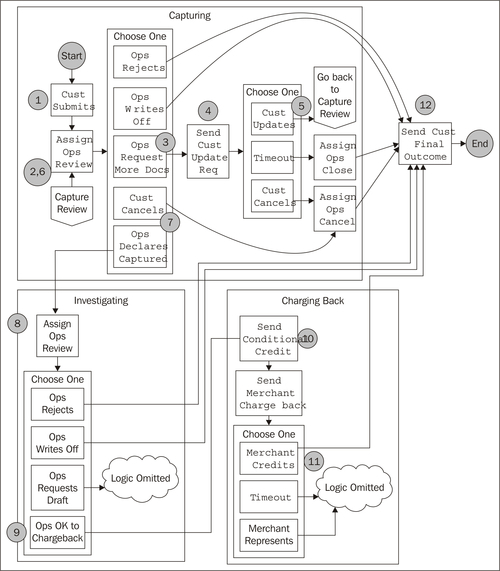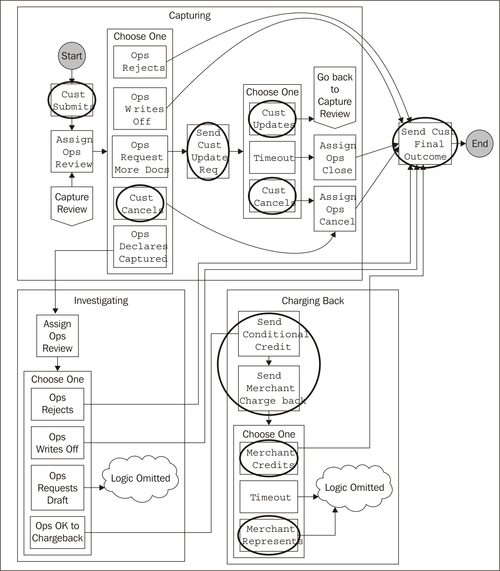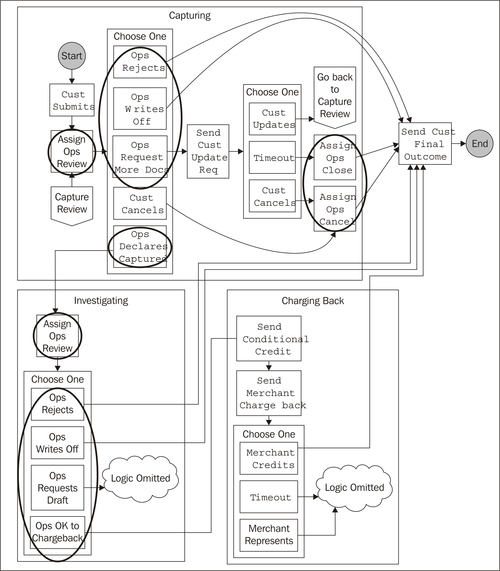The running example in this article is the disputes process for fictional ACMEBank. The process controls how ACMEBank handles complaints over charges
raised by its VISA card holders. The process has three stages:
The Capture Stage:
The customer submits a dispute over one of various channels (call
center, web, email, mail, or fax) to ACMEBank. The bank makes a quick
determination of whether to reject the dispute outright (for example,
because it was not submitted within 60 days of its posted date), write
it off (for example, because the dollar amount of the transaction is
below a certain threshold), request supporting documentation (for
example, receipts) from the customer, or pass it to one of the bank's
disputes specialists for further investigation. At any time during this
stage the customer may cancel the dispute. The goal of this stage is
either to capture the dispute completely or to dispense with it.
The Investigation Stage:
The dispute specialist examines the fully-captured dispute, and may
reject it, write it off, proceed with a chargeback (that is, take the
disputed amount back from the merchant), or request a sales draft from
the merchant to investigate its validity (and ask the customer for
clarification if the draft appears valid). The happy path culminates in a
chargeback decision.
The Chargeback Stage:
ACMEBank charges back the transaction and credits the customer's
account. The merchant bank may, in turn, accept the chargeback or
represent the transaction (that is, present the charge again), at which
point an ACMEBank disputes specialist determines whether to charge back a
second time, write off, or reject. In rare cases, the dispute is
brought to arbitration before the VISA association.
The next figure shows this process in flowchart form.

Assuredly, it's
not a trivial flow, but the logic is not difficult. The numbers in the
figure trace through a typical scenario, in which customer submits the
dispute, ACME's operations requests further documentation, the customer
provides it, ACME charges back the transaction, and the merchant agrees
to the chargeback. The steps are as follows:
The customer submits the dispute.
The Capturing stage begins. ACME's operations staff picks up the dispute for review.
Operations decides that it requires documentation from the customer.
The disputes process forwards this documentation request to the customer.
The customer responds with documentation.
Operations picks up the dispute for a second review.
Operations indicates that the dispute is now fully captured.
Operations picks up the dispute to begin the Investigation stage.
Operations decides to go ahead with chargeback.
The disputes process, commencing the Charging Back stage, credits the
customer's account and sends a chargeback notification to the merchant.
The merchant accepts the credit request.
The disputes process notifies the customer that the dispute is complete and the customer has won.
The following table
describes the purpose of each activity, identifies the role that
performs it, and indicates whether it is a call or an inbound event.
|
Name
|
Type
|
Role
|
Description
|
|---|
|
Cust Submits
|
Event
|
Customer
|
The customer submits a dispute to ACMEBank.
|
|
Cust Cancels
|
Event
|
Customer
|
The customer cancels the dispute.
|
|
Cust Updates
|
Event
|
Customer
|
The customer attaches new information to the dispute (for example, receipts).
|
|
Send Cust Update Req
|
Call
|
Customer
|
The dispute process prompts the customer to provide additional information for the dispute.
|
|
Send Cust Final Outcome
|
Call
|
Customer
|
The disputes process informs the customer that the dispute processing has completed.
|
|
Send Conditional Credit
|
Call
|
Customer
|
The disputes process informs the
customer that it has conditionally credited the customer's account for
the amount disputed. If the dispute is ultimately decided in the
merchant's favor, the credit is removed.
|
|
Ops Rejects
|
Event
|
Operations
|
Operations rejects the dispute
|
|
Ops Writes Off
|
Event
|
Operations
|
Operations writes off the dispute (that
is, it credits the customer without attempting to recover funds from the
merchant).
|
|
Ops Requests More Docs, Ops Requests Draft
|
Event
|
Operations
|
Operations, after reviewing the dispute,
requires more documentation from either the customer or the merchant.
|
|
Ops Declares Captured
|
Event
|
Operations
|
Operations decides that enough
information has been collected for the dispute to enter the
investigation stage.
|
|
Ops OK to Chargeback
|
Event
|
Operations
|
Operations decides enough investigation has been done to warrant proceeding with a chargeback.
|
|
Assign Ops Review
|
Call
|
Operations
|
The disputes process assigns operations to review the dispute in its current state.
|
|
Assign Ops Cancel
|
Call
|
Operations
|
The disputes process notifies operations that the customer has cancelled the dispute.
|
|
Assign Ops Close
|
Call
|
Operations
|
The disputes process prompts operations
to close off the dispute. The dispute has completed for a reason that
was not caused by operations itself. Possible causes are timeouts or an
arbitration ruling.
|
|
Merchant Credits
|
Event
|
Net Merchant Bank
|
The merchant accepts the chargeback.
|
|
Merchant Represents
|
Event
|
Net Merchant Bank
|
The merchant rejects the chargeback and represents the disputed transaction.
|
|
Send Merchant Chargeback
|
Call
|
Net Merchant Bank
|
The disputes process charges back the disputed transaction from the merchant bank.
|
|
Timeout
|
Event
|
None
|
The disputes process did not receive the event it expected within a certain time interval.
|
There are three roles in this process: the customer, operations, and the dispute network,
which serves as an interface to merchants, merchant banks, and the VISA
card association. Communications are bi-directional: the process can
call (or send a message to) a role and can receive events from a role.
The process uses a naming convention of send X (for example, Send Cust Update Req) for calls to the customer and dispute network roles, but assign X (for example, Assign Ops Review)
for operations calls. Operations is a human role (its activities are
performed by a group of back-office users), so it makes sense that the
process assigns
work to it. The customer and dispute network roles are automated systems
from the perspective of the disputes process; calling them means
sending messages, not assigning work.
The disputes
process thus has a mixture of BPM and SOA responsibilities. The
operations' interface requires a BPM platform, but the customer and
dispute network interfaces are best managed by an SOA platform. We need
to split the process, then, into SOA and BPM pieces. There are two
approaches to this:
Model the overall flow as a BPM process, but have it use small SOA
processes to manage interactions with the customer and network. The next
figure shows the BPM process, with SOA pieces indicated in
thick-bordered circles. The strategy, is for the BPM process to use smaller SOA processes to call
the customer and dispute network roles, and let SOA processes listen
for events from the roles and trigger the BPM process when they arrive.
This approach requires a BPM tool that supports calling and receiving
events from SOA processes.

Model the overall flow as an SOA orchestration process, but have it
use small BPM processes to handle the operations' tasks, as shown in the
next figure. The strategy is for the SOA process to treat the
operations interface as an automated interface, treating work assignment
as a call to a workflow system, and the completion of work as an event
back from the workflow system. The SOA process leaves BPM-specific
details, such as the logic of task assignment and escalation, to the
workflow system. We assume that the SOA tool has an interface to invoke
and receive events from the BPM platform. BEA's Weblogic Integration is
such a platform, as we demonstrate next.

Both approaches are
valid in this case. The SOA process has about as many circles as the
BPM process, which suggests that the SOA process has about as many BPM
dependencies as the BPM process has SOA dependencies. Counting circles
is a useful rule of thumb. As we discussed in the ‘Tips' section
earlier, there are additional factors that influence the design choices
concerning SOA and BPM.